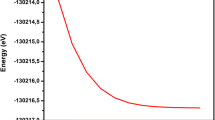Abstract
The electric field gradients (EFG) at the impurities Ni–Kr and Pd–Xe in the hcp metals Zn and Cd were calculated with the density functional code WIEN2k. Supercells with up to 150 atoms were used, resulting in a very good description of the available experimental data. Typical errors are 5–10%, with exceptions for Ag and Sb in Zn and for I in Zn and Cd, where a remeasurement is urged. The previously proposed systematic trend with positive EFG values for the first five impurity elements in every series and negative ones for the last three is confirmed.
Similar content being viewed by others
References
Haas, H.: Quadrupole interaction in metals: nuclear methods. Z. Naturforsch. A 41, 78–90 (1986)
Lindgren, B.: Self-consistent molecular-cluster calculation of the electric field gradient of 5 sp impurities (47Ag–58Xe) in cadmium. Phys. Rev. B 34, 648–653 (1986)
Schmidt, P.C., Weiss, A., Cabus, S., Kübler, J.: Self-consistent supercell band-structure calculations for the investigation of the electric field gradient at impurity sites in Cd metal. Z. Naturforsch A 42, 1321–1326 (1987)
Haas, H.: Nuclear quadrupole interaction in metals: experiments, calculations, models. Hyperfine Interact. 120, 493–509 (2000)
Ogura, M., Akai, H.: The full potential Korringa-Kohn-Rostoker method and its application in electric field gradient calculations. J. Phys. Condens. Matter 17, 5741–5755 (2005)
Vianden, R.: Electric field gradients in metals. Hyperfine Interact. 35, 1079–1118 (1987) and references therein
Christiansen, J., Heubes, P., Keitel, R., Klinger, W., Loeffler, W., Sandner, W., Witthuhn, W.: Temperature dependence of the electric field gradient in noncubic metals. Z. Phys B 24, 177–187 (1976)
Stone, N.J.: Table of nuclear magnetic dipole and electric quadrupole moments. At. Nucl. Data Tables 90, 75–176 (2005)
Blaha, P., Schwarz, K., Madsen, G.K.H., Kvasnicka, D., Luitz, J.: WIEN2k, an augmented plane wave + local orbitals program for calculating crystal properties (Karlheinz Schwarz, Techn. Universität Wien, Austria). ISBN 3-9501031-1-2 (2001)
Perdew, J.P., Burke, S., Ernzerhof, M.: Generalized gradient approximation made simple. Phys. Rev. Lett. 77, 3865–3868 (1996)
Van Walle, E., Vandenplassche, D., Nuytten, C., Wouters, J., Vanneste, L.: Electric field gradient of Ag in Zn. Phys. Rev. B 28, 1109–1112 (1983)
Herzog, P.: Comparative study of samples implanted at room temperature and below 1 K by NMR/ON and NO. Hyperfine Interact. 22, 151–162 (1985)
Ooms, H., Claes, J., Namavar, F., Rots, M.: The electric field gradient at iodine impurities in zinc and cadmium. Hyperfine Interact. 11, 1–12 (1981)
Author information
Authors and Affiliations
Corresponding author
Rights and permissions
About this article
Cite this article
Haas, H., Correia, J.G. The EFG at sp-impurities in Zn and Cd—a new (final?) look. Hyperfine Interact 197, 11–15 (2010). https://doi.org/10.1007/s10751-010-0212-5
Published:
Issue Date:
DOI: https://doi.org/10.1007/s10751-010-0212-5




